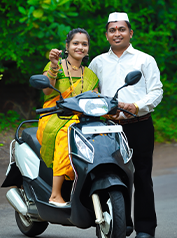
Table of Contents
Fixed deposits and Sukanya Samriddhi Yojana are both well-known savings schemes in India, offering guaranteed returns with minimal risk. However, each serves different financial objectives. Sukanya Samriddhi Yojana, launched by the Government of India under the Beti Bachao – Beti Padhao programme initiative, is designed specifically for the welfare of a girl child. It encourages parents or guardians to save for her higher education and marriage expenses by allowing them to open a Sukanya Samriddhi Account in her name before she turns 10.
Both SSY and FDs provide assured returns, but they differ significantly in terms of features, tenure, and investment amount. Understanding these differences will help you make an informed decision between Sukanya Samriddhi Yojana vs fixed deposit for your financial goals and the financial welfare of your family.
A fixed deposit is a deposit account offered by banks and NBFCs where individuals can invest a fixed sum of money for a predetermined period. FDs provide fixed interest rates throughout the tenure, making them one of the most predictable and secure options. Many banks offer an FD account as part of investment options, and some even allow you to open a fixed deposit for a girl child to build a corpus for her future needs.
Key Features of a Fixed Deposit
Here are some of the features of a fixed deposit that makes it a popular investment choice:
Guaranteed Returns
FDs offer fixed interest rates that remain unchanged throughout the tenure, providing predictable returns.
Tenure Range
The tenure for FDs ranges from 7 days to 10 years, depending on the bank or NBFC offering the FD account.
FD Interest Rates
The interest rate on FDs varies based on the institution and the tenure chosen. Rates currently range from 7% to 8.50% p.a., with slightly higher rates for senior citizens.
Minimum and Maximum Deposit Amount
The minimum deposit amount typically starts at ₹1,000. There is no upper limit on deposits for FDs.
Flexible Interest Payout Options
FDs allow flexibility in interest payouts. You can choose to receive the interest income monthly, quarterly, or at the time of maturity, based on your needs.
Premature Withdrawal
You can withdraw funds before the maturity period, but this may attract penalty charges that reduce your returns.
Loan Facility
Most banks and NBFCs offer loans against FDs, allowing you to borrow up to 90% of the deposit amount.
Tax Benefits
Certain FDs, like the 5-year tax-saver FD, offer tax benefits under Section 80C of the Income Tax Act, 1961. However, the interest income from FDs is taxable.
A fixed deposit is a deposit account offered by banks and NBFCs where individuals can invest a fixed sum of money for a predetermined period. FDs provide fixed interest rates throughout the tenure, making them one of the most predictable and secure options. Many banks offer an FD account as part of investment options, and some even allow you to open a fixed deposit for a girl child to build a corpus for her future needs.
Key Features of a Fixed Deposit
Here are some of the features of a fixed deposit that makes it a popular investment choice:
Guaranteed Returns
FDs offer fixed interest rates that remain unchanged throughout the tenure, providing predictable returns.
Tenure Range
The tenure for FDs ranges from 7 days to 10 years, depending on the bank or NBFC offering the FD account.
FD Interest Rates
The interest rate on FDs varies based on the institution and the tenure chosen. Rates currently range from 7% to 8.50% p.a., with slightly higher rates for senior citizens.
Minimum and Maximum Deposit Amount
The minimum deposit amount typically starts at ₹1,000. There is no upper limit on deposits for FDs.
Flexible Interest Payout Options
FDs allow flexibility in interest payouts. You can choose to receive the interest income monthly, quarterly, or at the time of maturity, based on your needs.
Premature Withdrawal
You can withdraw funds before the maturity period, but this may attract penalty charges that reduce your returns.
Loan Facility
Most banks and NBFCs offer loans against FDs, allowing you to borrow up to 90% of the deposit amount.
Tax Benefits
Certain FDs, like the 5-year tax-saver FD, offer tax benefits under Section 80C of the Income Tax Act, 1961. However, the interest income from FDs is taxable.
Refer the below table:
Parameters |
Fixed Deposit |
Sukanya Samriddhi Yojana |
|---|---|---|
Interest rate |
6% to 7.5% p.a. |
8.20% p.a. |
Eligibility |
18 years and above (parents can open for minors) |
From birth until 10 years |
Minimum deposit |
₹1,000 (varies by issuer) |
₹250 |
Maximum deposit |
No upper limit |
₹1.5 Lakhs annually |
Tax Exemption |
Section 80C for 5-year tax-saver FD |
Section 80C |
Tenure |
7 days to 10 years |
21 years or upon marriage |
Premature Withdrawal |
Allowed with penalties |
Allowed after 5 years under conditions |
Nomination Facility |
Available |
Not Available |
Loan Facility |
Available |
Not Available |
Tenure Extension |
Renew after maturity |
Not possible beyond 21 years |
1.Interest Rate
The interest rate on Sukanya Samriddhi Yojana is set by the Central Government and currently stands at 8.20% p.a. In contrast, FD interest rates are determined by the individual bank or NBFC, with rates ranging between 6% and 7.5% p.a.
2.Eligibility
SSY is available only for a girl child, and the account must be opened before she turns 10. FDs are open to all Indian residents aged 18 or above, though parents can also open deposit accounts for minors.
3.Minimum and Maximum Deposit
SSY requires a minimum deposit amount of ₹250, with a maximum annual deposit of ₹1.5 Lakhs. For FDs, the deposit amount typically starts at ₹1,000, with no upper limit on deposits.
4.Tenure
The lock-in period for Sukanya Samriddhi Yojana lasts until 21 years from the account opening. FDs offer more flexibility, with tenure options ranging from 7 days to 10 years.
5.Premature Withdrawal
SSY allows withdrawals under special conditions, such as the demise of the account holder or for the girl’s higher education. Bank FDs also allow withdrawal, but penalty charges may apply for early closure.
6.Tax Benefits
Both SSY and FDs offer tax benefits under Section 80C. However, SSY has the added advantage of tax-free interest income, while FD interest is taxable.
7.Tenure Extension
SSY does not allow account extensions beyond 21 years, whereas FDs can be renewed after their maturity.
Both fixed deposits and Sukanya Samriddhi Yojana are popular investment options in India, offering secure returns with minimal risk. However, each serves different financial goals. Below is a comparison of the key advantages and disadvantages of both.
Advantages of Fixed Deposit
Guaranteed Returns
FDs offer fixed interest rates, ensuring predictable returns, which is ideal for conservative investors seeking stability in their investment portfolio.
Flexibility in Tenure
FDs offer a wide tenure range from 7 days to 10 years, allowing you to choose the duration that best fits your financial goals.
Multiple Interest Payout Options
You can choose to receive interest income at regular intervals (monthly or quarterly) or at maturity, providing flexibility based on your financial needs.
Loan Facility
You can get a loan against your FD account, making it a reliable option in case of emergencies, as it provides liquidity without breaking the deposit.
Accessibility for All
FDs are widely available to anyone, including minors, with easy access through banks and NBFCs.
Disadvantages of Fixed Deposit
Lower Returns
FDs generally offer lower returns compared to other investment schemes, such as SSY or mutual funds, which may impact long-term growth.
Taxable Interest Income
The interest income from FDs is fully taxable under the Income Tax Act, 1961, reducing your overall returns, especially for those in higher tax brackets.
Penalty for Premature Withdrawal
Early withdrawal of funds from an FD may result in penalty charges, reducing the final amount earned.
Inflation Risk
The fixed interest rate on FDs may not keep up with inflation, potentially eroding the real value of your investment amount over time.
Advantages of Sukanya Samriddhi Yojana
Higher Interest Rate
The interest rate on Sukanya Samriddhi Yojana is 8.20% p.a., which is significantly higher than most FDs, making it one of the best investment plans for a girl child in India.
Tax Benefits
SSY offers attractive tax benefits under Section 80C of the Income Tax Act, 1961, and the interest income is entirely tax-free, unlike FDs.
Government-backed Security
SSY is a government-backed scheme, launched under the Beti Bachao – Beti Padhao initiative, offering financial security and stable returns.
Long-term Financial Security for Girl Child
SSY helps build a significant corpus to support future higher education or marriage expenses for a girl child, providing long-term financial planning.
Low Minimum Deposit
The minimum deposit amount for opening a Sukanya Samriddhi Account is just ₹250, making it accessible to all income groups.
Disadvantages of Sukanya Samriddhi Yojana
Restricted to Girl Child
SSY is exclusively for a girl child, meaning families without daughters cannot use this investment option.
Long Lock-in Period
The lock-in period for Sukanya Samriddhi Yojana is until the girl child turns 21, making it less flexible than FDs in terms of liquidity.
Limited Withdrawal Options
Partial withdrawals from SSY are allowed only after the girl turns 18, and only for specific purposes like higher education or marriage expenses.
No Loan Facility
Unlike FDs, SSY does not offer loans against the deposit, which could limit liquidity in emergencies.
No Tenure Extension
SSY does not allow tenure extensions beyond the maturity period, unlike FDs where you can renew the FD account upon maturity.
For parents looking for a secure way to save for their daughter’s future, Sukanya Samriddhi Yojana is regarded as one of the best investment plans for a girl child in India. Its high interest rate, tax-free returns, and long-term growth potential make it an ideal choice for building a future corpus for your daughter's higher education or marriage expenses.
Choosing between SSY vs FD depends on your financial goals. SSY is a good option if you want to invest specifically for a girl child and can lock in your investments for the long term. It offers a higher interest rate and tax benefits. FDs, on the other hand, provide flexibility in tenure, interest payouts, and early withdrawal options, making them a more general tool for securing your savings.
Both Sukanya Samriddhi Yojana and fixed deposits are reliable savings schemes with low risk and guaranteed returns. SSY is specifically designed for the long-term financial well-being of a girl child, offering higher interest rates and tax-free benefits. FDs, however, offer greater flexibility in terms of tenure, withdrawals, and tax treatment, making them suitable for broader financial goals.
It depends on your goals. SSY offers higher returns and tax benefits but is limited to a girl child. FDs offer more flexible tenure and withdrawal options.
Yes, the interest income from FDs is taxable based on your tax treatment under the Income Tax Act.
Yes, contributions and the interest income earned under SSY are tax-free, as per Section 80C of the Income Tax Act, 1961.
The minimum deposit amount for SSY is ₹250, while FDs generally require ₹1,000 or more, depending on the institution.
FD rates for minors are the same as for adults, but some banks offer special deposit accounts or slightly higher rates for senior citizens.
It could be one of the best investment plans for a girl child in India, offering high interest rates and tax-free growth.
Funds can be transferred through Internet Banking, cash, cheque, or other online methods such as NEFT/RTGS.
To open a Sukanya Samriddhi Account, you need the child's birth certificate, along with the guardian’s identity and address proofs.
Most Viewed
Academy by Bajaj Markets












